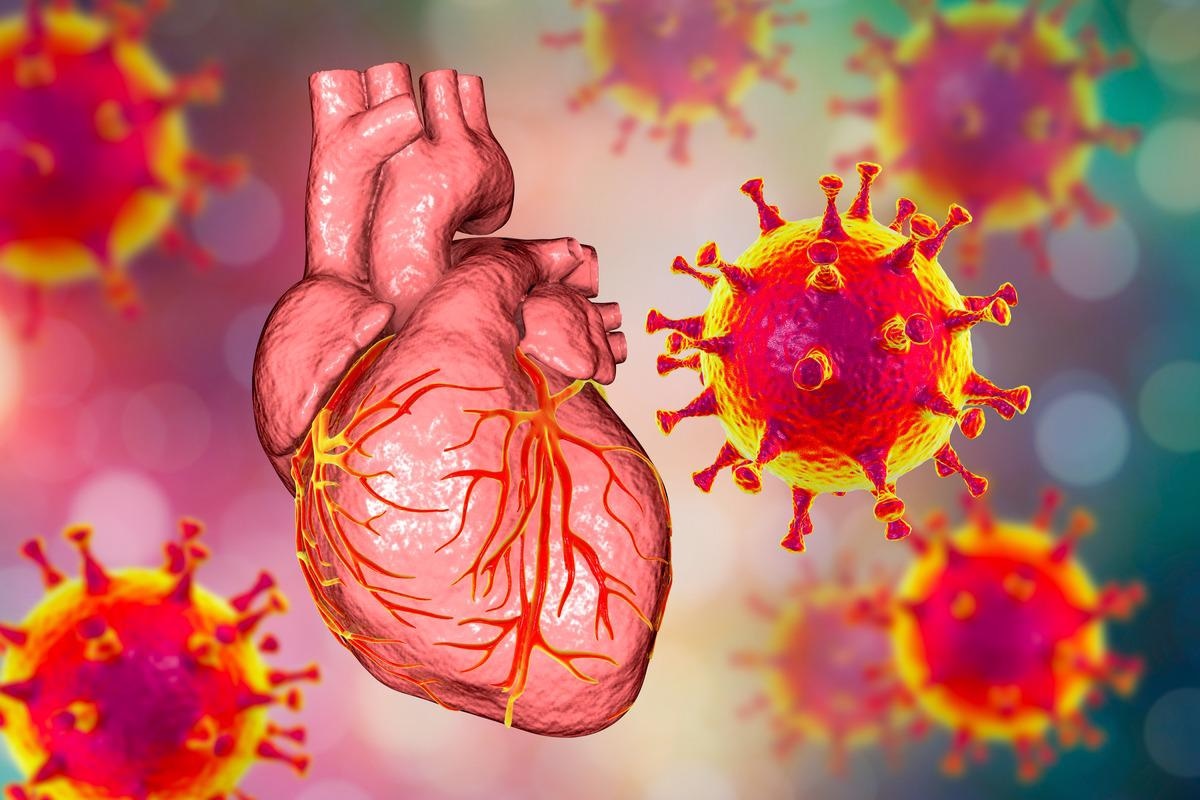In a study published in the journal Bioengineered, a team of researchers used bioinformatics tools to explore the biological characteristics of severe acute respiratory syndrome coronavirus 2 (SARS-CoV-2)-infected myocardium.
 Study: Inflammatory activation and immune cell infiltration are main biological characteristics of SARS-CoV-2 infected myocardium. Image Credit: Kateryna Kon/Shutterstock
Study: Inflammatory activation and immune cell infiltration are main biological characteristics of SARS-CoV-2 infected myocardium. Image Credit: Kateryna Kon/Shutterstock
SARS-CoV-2 directly invades the human heart by targeting cardiomyocytes (CMs), resulting in myocardial injury, one of the pathogenic features observed in the systemic symptoms caused by SARS-CoV-2 infection. Myocardial injury substantially increases the risk of mortality in coronavirus disease 2019 (COVID-19) patients.
Previous reports have demonstrated the existence of viral RNA and macrophages in clinical heart samples, suggesting direct and indirect virus-induced damage to the myocardium, indicating the inclination of the SARS-CoV-2 to infect CMs over fibroblasts and endothelial cells. However, the downstream effects on these cells post SARS-CoV-2 infection have not been investigated.
About the study
The researchers of the present study examined the biological characteristics of SARS-CoV-2-infected CMs based on omics by collecting transcriptome data and analyzing them using several bioinformatics tools.
After re-analyzing the three datasets of SARS-CoV-2 infected human CMs - GSE150392, GSE151879, and GSE169241 - the researchers selected the differentially expressed genes (DEGs) and enrolled them for gene ontology (GO) and Kyoto encyclopedia of genes and genomes (KEGG) analysis, and protein-protein interaction (PPI) network construction.
Further, they screened transcription factors (TFs) and microRNAs (miRNAs) responsible for the expression of DEGs. Besides, they predicted some potential therapeutic drugs for COVID-19 patients, for which they analyzed DEGs in the Connectivity Map (cMap) database.
Furthermore, these DEGs in SARS-CoV-2 infected human hearts were re-analyzed to validate the DEGs of in vitro results. Finally, based on the in vivo results, the researchers performed gene set enrichment analysis (GSEA) and evaluated immune infiltration.
Findings
A total of 86 DEGs were discovered in SARS-CoV-2-infected CMs, concurrently up-regulated or down-regulated in all datasets, indicating the existence of several internal biological differences among these CMs when exposed to SARS-CoV-2. Among the 86 DEGs, 28 were found to be dysregulated in SARS-CoV-2 infected hearts (in vivo), further validating the results of the in vitro model.
The analysis showed a total of 15 miRNAs targeting 60 genes, of which miR-1-3p and miR-27a-3p had the most target genes. Past research studies have demonstrated that miR-1-3p increases in peripheral blood and positively correlates with the level of myocardial damage in acute viral myocarditis. Therefore, its circulating form may be a potential indicator of SARS-CoV-2-induced myocardial injury, a phenomenon worth exploring in future studies. Besides, its extensive association with multiple DEGs suggests that it is also a potentially valuable intervention target.
GO analysis showed that all 86 DEGs were substantially enriched in response to stimulus, biological regulation, and metabolic processes. However, more abundant information was gathered using GSEA analysis on KEGG, which showed that these DEGs were specifically enriched in the inflammatory signaling pathways, including interleukin (IL)-17 signaling pathway and complement and coagulation cascades, which play vital roles in viral myocarditis.
The activation of the IL-17 signaling pathway, mediated by the cytokine storm, marks SARS-CoV-2 infection. Additionally, complement and coagulation cascade actively participate in the cardiac anomaly, suggesting that COVID-19-induced myocardial injury may occur partly due to microcirculatory thrombosis. Overall, these findings suggest that anti-inflammatory treatments could effectively fight myocardial injury in COVID-19 patients.
Immune infiltration analysis indicated that naive B cells were significantly increased in the SARS-CoV-2-infected heart, indicating the activation of adaptive or humoral immune responses in COVID-19 patients.
The increased B cell infiltration also shows functional deterioration in the hearts of COVID-19 patients; therefore, appropriate inhibition of naive B cells might effectively alleviate COVID-19-induced heart damage.
All 86 DEGs were matched with molecules in the cMAP database to explore therapeutic drugs for COVID-19 prognosis. From a total of 2429 small molecules, several molecules displayed the potential to reduce the SARS-CoV-2 induced CMs injury. One such antiviral molecule was saracatinib, which has been considered as a potential drug for SARS-CoV-2 in two different research studies. However, the effectiveness of saracatinib in preventing SARS-CoV-2-induced myocardial tissue damage needs further investigation.
Conclusions
To summarize, the study results could prove to be very useful for the prognosis of patients with COVID-19. The authors identified potential biomarkers in SARS-CoV-2-infected CMs and discovered potential immune cell intervention targets and valuable therapeutic drugs.
However, future studies must further investigate and confirm these preliminary findings.